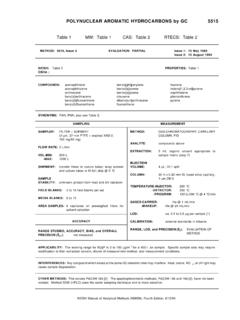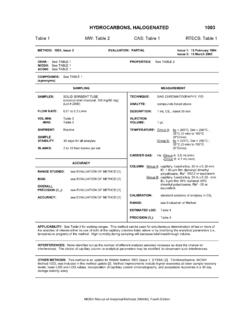Transcription of Technical Fact Sheet – Polybrominated Diphenyl Ethers …
1 United States Office of Land and Emergency EPA 505-F-17-015 Environmental Protection Agency Management (5106P) November 2017 1 Technical Fact Sheet Polybrominated Diphenyl Ethers (PBDEs) November 2017 Introduction This fact Sheet , developed by the Environmental Protection Agency (EPA) Federal Facilities Restoration and Reuse Office (FFRRO), provides a summary of the contaminant groups Polybrominated Diphenyl Ethers (PBDEs), including physical and chemical properties; environmental and health impacts; existing federal and state guidelines; detection and treatment methods; and additional sources of information. This fact Sheet provides basic information on PBDEs to site managers and other field personnel who may encounter these contaminants at cleanup sites. PBDEs have been used widely in the United States since the 1970s; however, there is growing concern about their persistence in the environment and their tendency to bioaccumulate (ATSDR 2015; EPA 2009).
2 What are PBDEs? PBDEs are brominated hydrocarbons in which 2-10 bromine atoms are attached to the molecular structure (ATSDR 2015). PBDEs are used as flame retardants in a wide variety of products, including plastics, furniture, upholstery, electrical equipment, electronic devices, textiles and other household products (ATSDR 2015; EPA 2009). At high temperatures, PBDEs release bromine radicals that reduce both the rate of combustion and dispersion of fire (Hooper and McDonald 2000). PBDEs exist as mixtures of distinct chemicals called congeners with unique molecular structures (ATSDR 2015; EPA 2009). There are three types of commercial PBDE mixtures, including pentabromodiphenyl ether (pentaBDE), octabromodiphenyl ether (octaBDE) and decabromodiphenyl ether (decaBDE). DecaBDE is the most widely used PBDE globally (ATSDR 2015; EPA 2009).
3 The production of octaBDE and pentaBDE in the United States ceased at the end of 2004 after the voluntary phase-out of these chemicals by the only manufacturer. In 2009, the two producers and the main importer of decaBDE announced plans to phase out the compound by the end of 2013 (EPA 2013). At a Glance Classes of brominated hydrocarbons that serve as flame retardants for electrical equipment, electronic devices, furniture, textiles and other household products. Structurally similar and exhibit low to moderate volatility. Lower brominated congeners of PBDE tend to bioaccumulate more than higher brominated congeners. Exposure in rats and mice caused thyroid hormone bioactivity, neuro-developmental toxicity and other symptoms. According to EPA, evidence of carcinogenic potential is suggested for decaBDE.
4 Detection methods include gas chromatography, mass spectrometry and liquid chromatography. Potential treatment methods being evaluated at the laboratory scale include debromination using zero-valent iron (ZVI) and nanoscale ZVI, activated carbon treatment and enhanced biodegradation. Disclaimer: The EPA prepared this fact Sheet using the most recent publicly-available scientific information; additional information can be obtained from the source documents. This fact Sheet is not intended to be used as a primary source of information and is not intended, nor can it be relied upon, to create any rights enforceable by any party in litigation with the United States. Mention of trade names or commercial products does not constitute endorsement or recommendation for use. Technical FACT Sheet PBDEs 2 Technical Fact Sheet PBDEs In 2014, EPA identified 29 potentially functional, viable alternatives to decaBDE for use in select polyolefins, styrenics, engineering thermoplastics, thermosets, elastomers, or waterborne emulsions and coatings (EPA 2014).
5 There are no known natural sources of PBDEs, except for a few marine organisms that produce forms of PBDEs that contain higher levels of oxygen (ATSDR 2015). PBDEs are structurally similar to polychlorinated biphenyls (PCBs). PBDEs are fat-soluble and hydrophobic (Hooper and McDonald 2000; NTP 2014). Exhibit 1: Physical and Chemical Properties of PBDEs (ATSDR 2015) Property PBDEs PentaBDE OctaBDE DecaBDE Chemical Abstracts System (CAS) number 32534-81-9 32536-52-0 1163-19-5 Physical description (physical state at room temperature) Clear, amber to pale yellow liquid Off-white powder Off-white powder Molecular weight (g/mol) Mixture Mixture Water solubility at 25 C ( g/L) (commercial) Less than 1 (commercial) Less than 1 Boiling point ( C) Over 300 Over 330 (decomposes) Over 320 (decomposes) Melting point ( C) -7 to -3 (commercial) 85 to 89 (commercial) 290 to 306 Vapor pressure at 25 C (mm Hg) x 10-7 to x 10-7 x 10-10 to x 10-9 x 10-8 Octanol-water partition coefficient (log Kow) to (commercial) Soil organic carbon-water coefficient (log Koc) to a to a a Henry s law constant at 25 C (atm-m3/mol)
6 X 10-5 a x 10-8 a x 10-6 a Abbreviations: g/mol gram per mole; g/L micrograms per liter; C degrees Celsius; mm Hg millimeters of mercury; atm-m3/mol atmosphere-cubic meters per mole. a Estimated value Existence of PBDEs in the environment PBDEs may enter the environment through emissions from manufacturing processes, volatilization from various products that contain PBDEs, recycling wastes and leachate from waste disposal sites (ATSDR 2015; EU 2001). PBDEs have been detected in air, sediments, surface water, fish and other marine animals (ATSDR 2015; EPA 2009). Based on a very limited number of studies, biodegradation does not appear to be significant for PBDEs (ATSDR 2015). Higher brominated congeners of PBDE tend to bind to sediment or soil particles more than lower brominated congeners (ATSDR 2015).
7 PBDEs do not dissolve easily in water and bind strongly to soil or sediment particles. This reduces their mobility in soil, sediment, surface and groundwater, but increases their mobility in the atmosphere, where they are attached to airborne particulate matter (ATSDR 2015). Volatilization from soil surfaces is expected to be low to moderate, depending on the number of bromine atoms. More brominated congeners (higher numbers of bromine atoms) tend to exhibit lower volatilities (EPA 2009; NTP 2014). Even though PBDEs are stable, they are susceptible to photolytic debromination when they are exposed to ultraviolet light (ATSDR 2015). As of 2016, PBDEs were not identified at any of the current or former hazardous waste sites on the EPA National Priorities List (NPL); however, the number of sites evaluated for PBDEs is not well documented (EPA 2016).
8 3 Technical Fact Sheet PBDEs What are the routes of exposure and the potential health effects of PBDEs? Routes of potential human exposure to PBDEs are ingestion, inhalation or dermal contact (NTP 2014). Traces of PBDEs have been detected in samples of human tissue, human blood and breast milk (EPA 2009; He and others 2006) According to EPA, evidence of carcinogenic potential is suggested for decaBDE (EPA 2009; EPA IRIS 2008). Neither the Department of Health and Human Services (DHHS) nor the International Agency for Research on Cancer (IARC) has classified the carcinogenicity of any PBDEs (IARC 2016; NTP 2014). However, the National Toxicology Program (NTP) evaluated a pentabromodiphenyl ether mixture in a rodent bioassay and concluded there was clear evidence of carcinogenicity in each species/sex tested (NTP 2014).
9 Studies in rats and mice show that PBDEs cause neurotoxicity, developmental neurotoxicity, reproductive toxicity, thyroid toxicity, immunotoxicity, liver toxicity, pancreas effects (diabetes) and cancer (penta and decabromodiphenyl ether). There may be differences in the severity of effects depending on bromination level (ATSDR 2015; Birnbaum and Staskal 2004; EPA 2009). Studies on animals and humans show that some PBDEs can act as endocrine system disruptors and tend to deposit in human adipose tissue (ATSDR 2015; Birnbaum and Staskal 2004; He and others 2006; NTP 2014). Studies indicate that octaBDE is a teratogen (a prenatal developmental toxin) (Darnerud and others 2001; He and others 2006).Are there any existing federal and state guidelines and health standards for PBDEs? EPA has established the following chronic oral reference doses (RfDs) for PBDEs (EPA 2017): PBDE Congener Milligrams per kilogram per day (mg/kg/day) 2,2',3,3',4,4',5,5',6,6' decaBDE-209 congener 7 x 10-3 octaBDE congener 3 x 10-3 pentaBDE congener 2 x 10-3 2,2 ,4,4 - tetrabromodiphenyl ether (tetraBDE-47) congener 1 x 10-4 2,2 ,4,4 ,5,5 - hexabromodiphenyl ether (hexaBDE-153) congener 2 x 10-4 2,2 ,4,4 ,5 - pentaBDE-99 congener 1 x 10-4 For decaBDE-209, EPA has assigned an oral slope factor for carcinogenic risk of 7 x 10-4 (mg/kg/day)-1 and a drinking water unit risk of x 10-8 micrograms per liter ( g/L) (EPA IRIS 2008).
10 EPA risk assessments indicate that the drinking water concentration representing a 1 x 10-6 cancer risk level for decaBDE-209 is 50 g/L (EPA IRIS 2008). EPA has calculated the following screening levels for residential soil, industrial soil and tap water (EPA 2017): Chemical Residential Soil (mg/kg) Industrial Soil (mg/kg) Tap Water ( g/L) decaBDE-209 440 3,300 110 octaBDE 190 2,500 61 pentaBDE 160 2,300 40 tetraBDE-47 82 hexaBDE-153 13 160 pentaBDE-99 82 For lower brominated PBDEs, the Agency for Toxic Substances and Disease Registry (ATSDR) has established a minimal risk level (MRL) of milligrams per cubic meter for intermediate-duration inhalation exposure. In addition, ATSDR established an MRL of 6 x 10-5 mg/kg/day for acute-duration oral exposure and 3 x 10-6 mg/kg/day for intermediate-duration oral exposure (ATSDR 2016).












